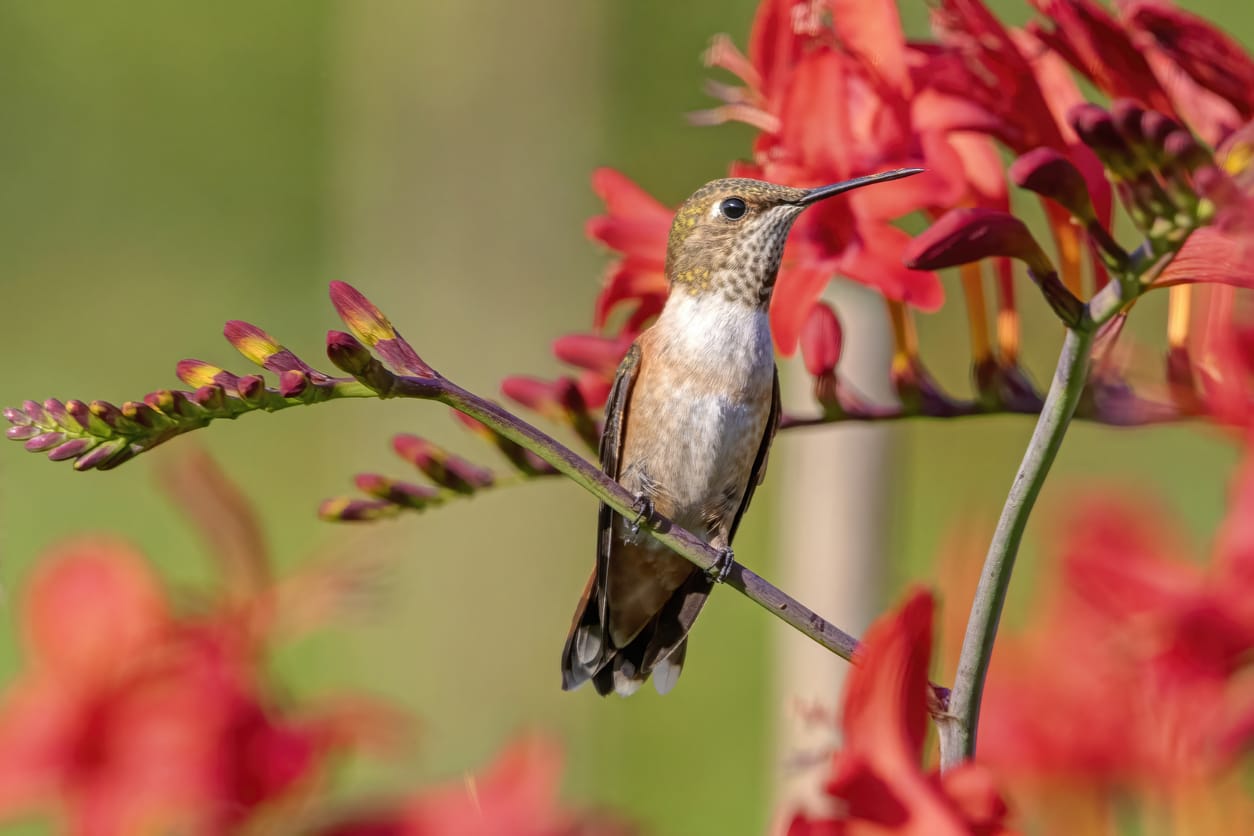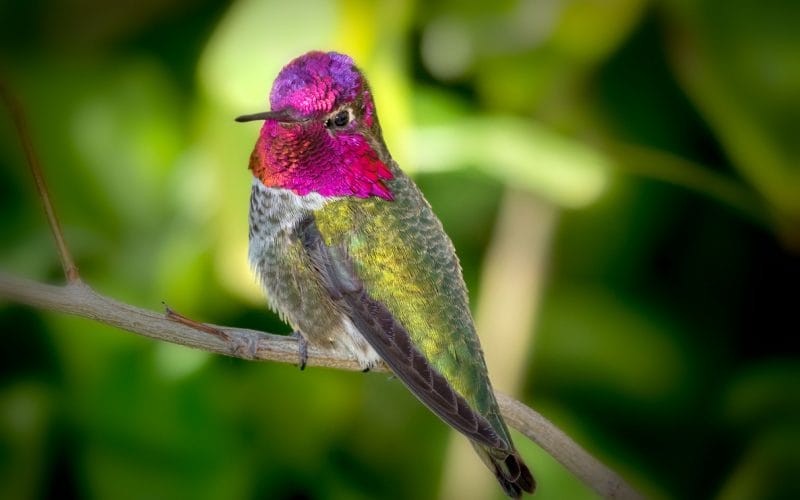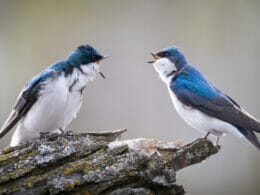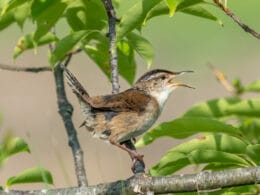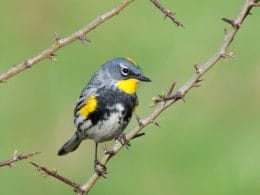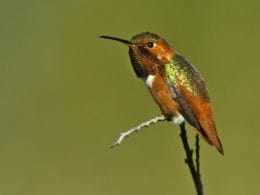Georgia is a wonderful destination for wildlife enthusiasts thanks to its extensive range of natural landscapes that make it a home for a wide variety of animals. From foxes and rattlesnakes to sea turtles and alligators, the Peach State has got it all!
If you’re interested in bird watching, Georgia surely won’t disappoint.
The state has a long list of birds, 427 species to be exact were documented by the Checklist and Records Committee of the Georgia Ornithological Society (GOSRC) as of August 2020. Additionally, there are 7 extra species categorized as provisional.
Out of these hundreds of bird species, you can spot over a dozen species of hummingbirds in Georgia. Today, we’re sharing interesting facts and information about the 13 hummingbirds you can come across in the Peach State.
13 Beautiful Hummingbirds in Georgia
The following are 13 stunning species of hummingbirds that you can see across the Peach state:
1. Rufous Hummingbird

- Scientific name: Selasphorus rufus
- Length: 2.8 to 3.5 inches (7 to 9 cm)
- Weight: 0.1 to 0.2 ounces (2 to 5 g)
- Wingspan: 4.3 inches (11 cm)
Rufous Hummingbirds are one of the most commonly spotted hummingbird species in Georgia. These birds have tiny bodies with straight beaks and tapered tails.
Top Tip: Rufous Hummingbirds like to stay in grasslands, open areas, forests, yards, and parks. The best time to see them in the Peach State is during the winter months.
Appearance-wise, male Rufous Hummingbirds possess a rich copper orange color all over their backs, undersides, and heads with an iridescent orange throat. The females feature the same copper orange color but only on the flanks with green marks on their backs.
2. Ruby-throated Hummingbird

- Scientific name: Archilochus colubris
- Length: 2.8 to 3.5 inches (7 to 9 cm)
- Weight: 0.1 to 0.2 ounces (2 to 6 g)
- Wingspan: 3.1 to 4.3 inches (8 to 11 cm)
Another hummingbird species that are regularly seen in Georgia is the Ruby-throated Hummingbird. It’s the only species that breeds on the Mississippi River’s east coast.
Ruby-throated Hummingbirds are known to be frequent visitors of feeders and flowers shaped like tubes. They even tend to chase away other birds from these food sources.
These tiny birds typically live in woodlands, grasslands, forest edges, and meadows. They also stay in parks, backyards, and gardens.
Male Ruby-throated Hummingbirds feature a unique reddish-orange throat. It shimmers when light hits right but appears dark in poor lighting.
Both males and females show off a glittery green color on top and a buff color below. They possess short wings that don’t reach their tails when perched.
3. Mexican Violetear
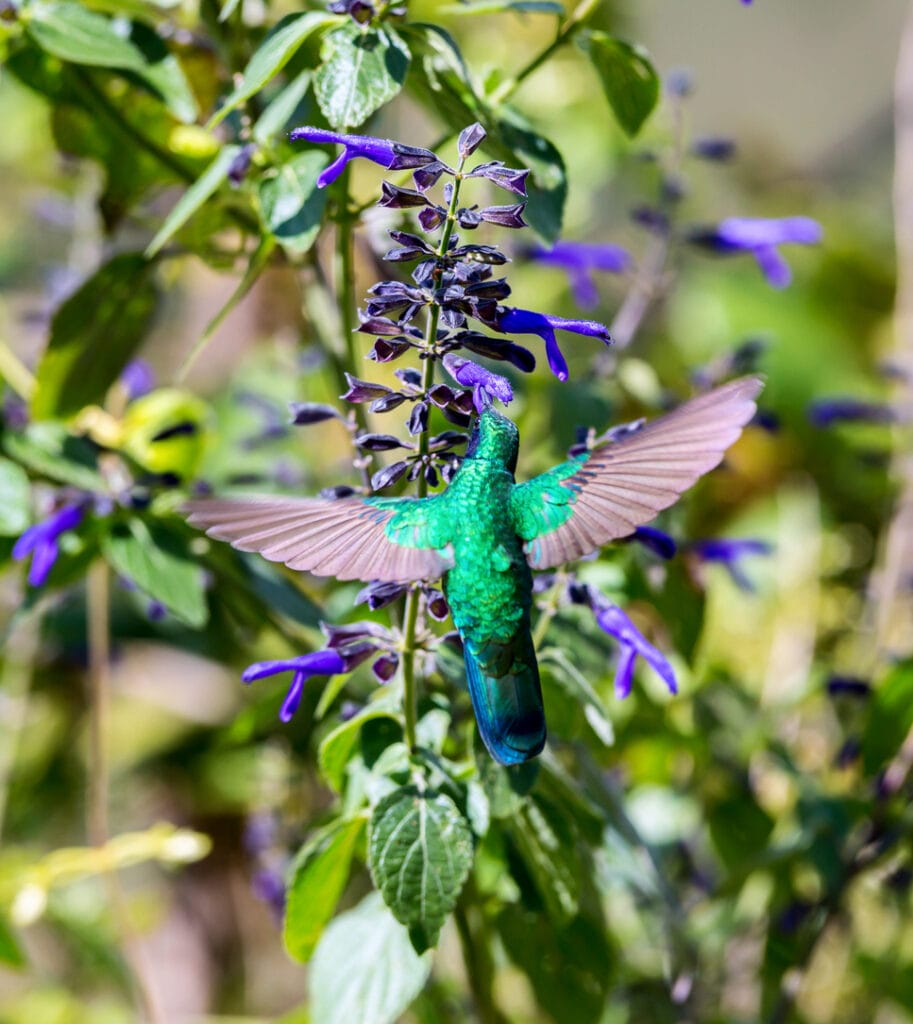
- Scientific name: Colibri thalassinus
- Length: 3.8 to 4.7 inches (9.7 to 12 cm)
- Weight: 0.17 to 0.2 ounces (4.8 to 5.6 g)
- Wingspan: 7 inches (17.8 cm)
Compared to other hummingbirds, the Mexican Violetear is considered medium-sized. Along with the Mountain Violet-ear, it was known as the Green Violetear back when the two hummingbirds were considered the same species.
In Georgia, the Mexican Violetear is a rare sight. These hummingbirds are residents of Central America and Mexico but some may accidentally visit the Peach State during their non-breeding season as they travel up north to the United States.
The Mexican Violetear features a metallic green color all over its body with bluish-purple patches on the breast and the sides of the head. Its throat and underside are also shiny green.
4. Rivoli’s Hummingbird

- Scientific name: Eugenes fulgens
- Length: 4.3 to 5.5 inches (11 to 14 cm)
- Weight: 0.2 to 0.3 ounces (7 to 8 g)
- Wingspan: 7.1 inches (18 cm)
Rivoli’s Hummingbirds are among the largest hummingbird species you can spot throughout the United States. In Georgia, they’re uncommon visitors as they mostly live in Mexico and travel during winter to southern New Mexico and Arizona.
The habitat of these birds is usually mountainous areas, especially parts that are close to creeks and streams. They prefer high elevations (around 5,000 to 9,000 feet up) for nesting and foraging.
Author Note: Previously known as Magnificent Hummingbirds, male Rivoli’s Hummingbirds are green on top and blackish green below. They possess a gorgeous purple cap along with an emerald green throat, both of which shimmer in good lighting but appear black in poor lighting.
Females Rivoli’s Hummingbirds are much duller with a grass green color on their backs and grey on the undersides. There’s a white stripe behind the eyes in both males and females.
Rivoli’s Hummingbirds follow a feeding strategy called trap-lining and their diet consists of nectar and small insects.
5. Blue-throated Mountain-gem
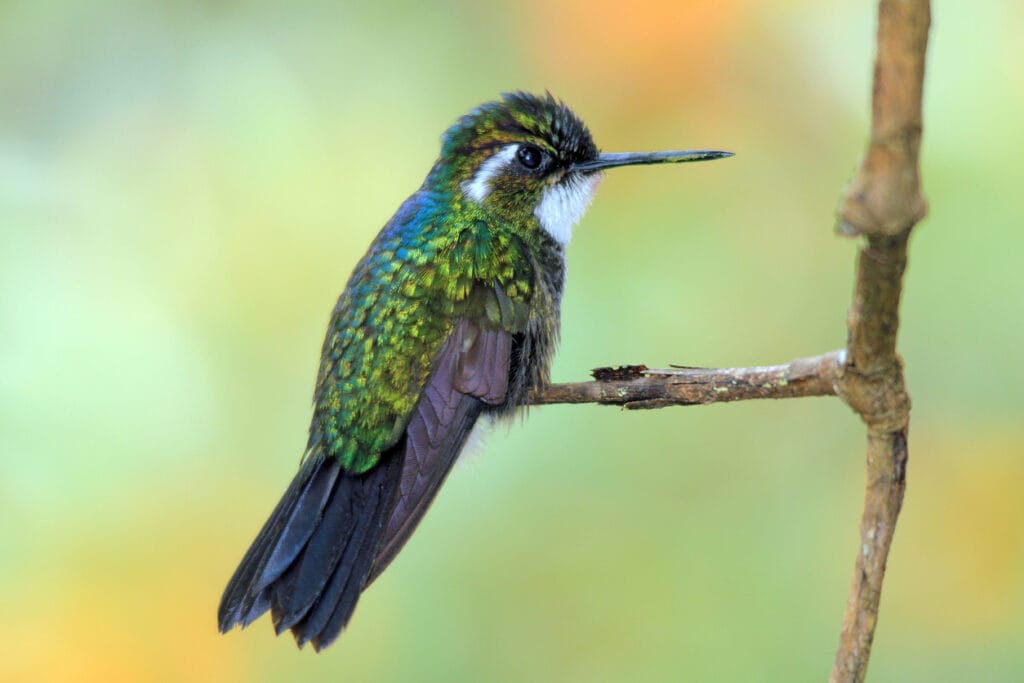
- Scientific name: Lampornis clemenciae
- Length: 4.3 to 4.7 inches (11 to 12 cm)
- Weight: 0.25 to 0.3 ounces (8.1 to 8.6 g)
- Wingspan: 3.1 inches (7.9 cm) for males and 2.3 inches (6.9 cm) for females
The Blue-throated Mountain-gem is a rare hummingbird species to spot in the Peach State but it’s not impossible. Also called the Blue-throated Hummingbird, this species is pretty large compared to other hummingbirds.
The Blue-throated Mountain-gem tends to nest in mixed and coniferous woodlands in regions close to creek beds and with a lot of flowers. They like to stay in elevations between 3,000 and 12,000 feet.
These hummingbirds are frequent visitors of nectar feeders. Keep in mind, however, that they’re somewhat aggressive and will bully smaller birds to keep them away from the feeders until they’re done.
Male Blue-throated Hummingbirds possess an iridescent royal blue throat that appears clearly when the light hits it right. Otherwise, it looks like a dark patch.
Both males and females are green on top and grey below with white tips on their black tail feathers. The females and young males don’t have a blue throat.
6. Green-breasted Mango

- Scientific name: Anthracothorax prevostii
- Length: 4.3 to 4.7 inches ( 11 to 12 cm)
- Weight: 0.24 to 0.25 ounces (6.8 to 7.2 g)
- Wingspan: 5 to 6 inches (13 to15 cm)
Another rare hummingbird species to see in the Peach State is the Green-breasted Mango. Its scientific name is a tribute to Florent Prévost, a French naturalist.
As its name suggests, the Green-breasted Mango features a shimmery green plumage on top. Males possess blue undersides whereas females have white breasts with a black line running down the center.
Top Tip: These hummingbirds reside in tropical areas around Central America and Mexico, consequently, their presence in Georgia is always accidental. It was first recorded visiting a feeder in 2007.
7. Black-chinned Hummingbird
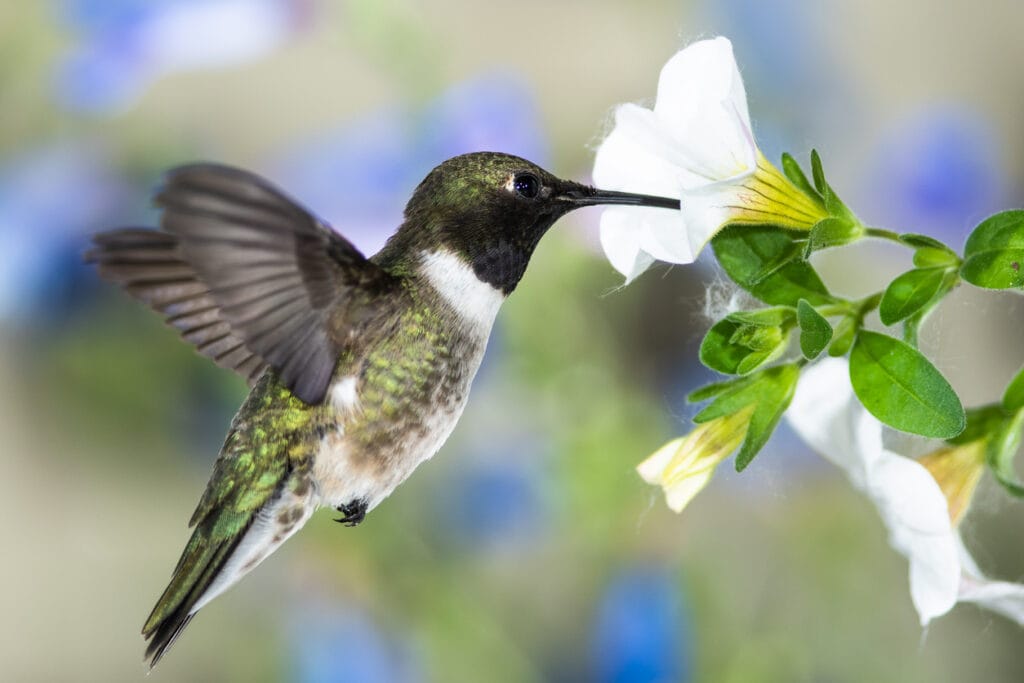
- Scientific name: Archilochus alexandri
- Length: 3.5 inches (9 cm)
- Weight: 0.1 to 0.2 ounces (2.3 to 4.9 g)
- Wingspan: 4.3 inches (11 cm)
The Black-chinned Hummingbird is commonly sighted in the western regions of the United States. It prefers areas with dry climates, long trees, and lots of flowering plants, but it’ll also visit suburbs and backyards.
In Georgia, this species isn’t a regular occurrence, yet it has been spotted several times across the Peach State. Your best chance is during the fall and winter until mid-spring.
The Black-chinned Hummingbird’s size is about the same as the Ruby-throated Hummingbird. It has a thin body and a coal-black almost straight beak.
As for the color pattern, both males and females show metallic green plumage on top and pale grey feathers below.
Males of the species feature a black throat with a purple streak at its end. Females don’t have dark throats, but their tails have wide white tips on the 3 outer feathers.
8. Allen’s Hummingbird
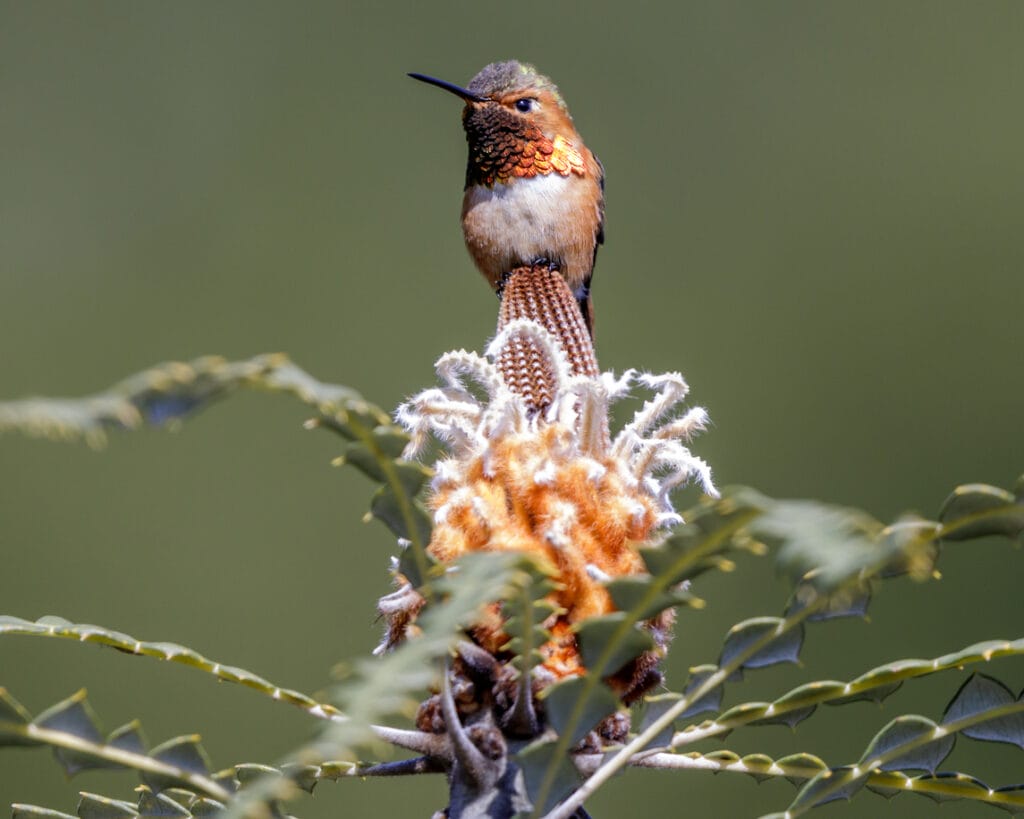
- Scientific name: Selasphorus sasin
- Length: 3.5 in (9 cm)
- Weight: 0.07 to 0.14 ounces (2 to 4 g)
- Wingspan: 4.3 inches (11 cm)
Named after the naturalist who discovered it, Charles A. Allen, this hummingbird species looks pretty similar to Rufous Hummingbirds as the males also possess vibrant orange throats and a coppery plumage. Both birds can even show green spots on their backs!
The main habitat of Allen’s Hummingbirds is across the western coast of southern Oregon and California. In Georgia, your best shot of spotting Allen’s Hummingbird is during the fall and winter. It’s one of the more uncommon species of hummingbirds in Georgia.
9. Anna’s Hummingbird
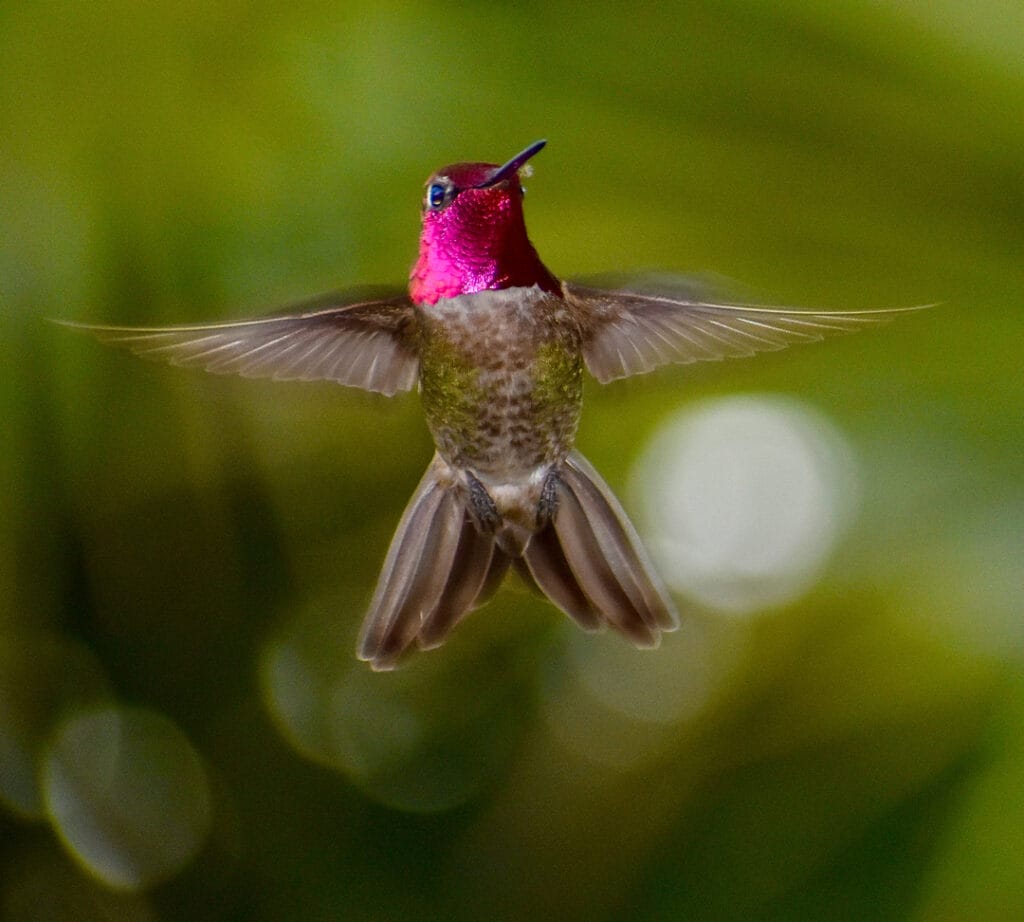
- Scientific name: Calypte anna
- Length: 3.9 inches (10 cm)
- Weight: 0.1 to 0.2 ounces (3 to 6 g)
- Wingspan: 4.7 inches (12 cm)
Anna’s Hummingbirds don’t migrate, unlike many other hummingbird species. They mainly reside in California, Arizona, and a few other western states.
Anna’s Hummingbirds are a somewhat rare sight in Georgia, but there’s a chance you can spot them during the fall until late winter. It’s named as a tribute to Anna Massena, the Duchess of Rivoli.
Author Note: Looks-wise, Anna’s Hummingbirds are stocky with medium-sized bodies, wide tails, and short beaks. They feature multiple shades of green and grey all over.
Males possess a hot pink patch on their throats and heads that shimmer under direct sunlight but appear brown otherwise.
10. Calliope Hummingbird
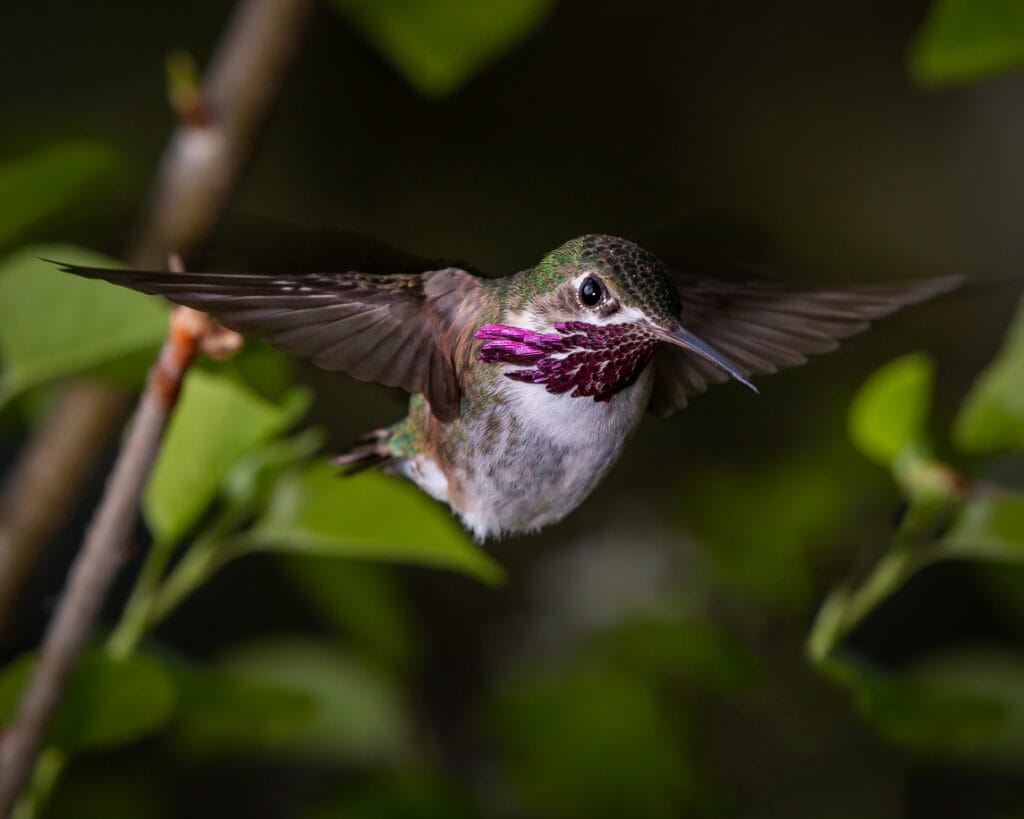
- Scientific name: Selasphorus calliope
- Length: 3.1 to 3.5 inches (8 to 9 cm)
- Weight: 0.08 to 0.12 ounces (2.3 to 3.4 g)
- Wingspan: 4.1 to 4.3 inches (10.5 to 11 cm)
You can spot the Calliope Hummingbird in western areas of the Peach State between fall and early spring. However, this is a rare occurrence since the main range of this species is the western part of the United States.
The Calliope Hummingbird is the smallest hummingbird species in North America. The male population features distinct magenta-colored lines radiating across its throat.
Both males and females are green and gold on top, but the males are green below while the females have peachy undersides.
11. Broad-billed Hummingbird

- Scientific name: Cynanthus latirostris
- Length: 3.1 to 3.9 inches (8 to 10 cm)
- Weight: 0.07 to 0.14 ounces (2 to 4 g)
- Wingspan: 5.1 inches (13 cm)
The Broad-billed Hummingbird isn’t a common sight in Georgia, but there have been multiple reports of their visits to the Peach State. Your best shot to see it is during the winter and early spring.
Broad-billed Hummingbirds have small bodies, long notched tails, straight beaks. Males possess a glittery green-blue plumage and bright red bills with black on the tip.
Females, on the other hand, are covered in green, grey, and buff feathers with a white line behind their eyes.
12. Broad-tailed Hummingbird

- Scientific name: Selasphorus platycercus
- Length: 3.1 to 3.5 inches (8 to 9 cm)
- Weight: 0.1 to 0.2 ounces (2.8 to 4.5 g)
- Wingspan: 5.25 inches (13 cm)
The Broad-tailed Hummingbird is another uncommon species to spot in Georgia. However, there’s a chance you could see it around the western parts of the state during fall and winter.
Author Note: Male Broad-tailed Hummingbirds show a characteristic light magenta throat. Both sexes are bright shimmering green on the back and head with a buff olive color on their breasts and a pale ring surrounding their eyes.
These birds like nesting in high locations in evergreen and pine-oak forests, woodlands, and meadows.
13. Buff-bellied Hummingbird
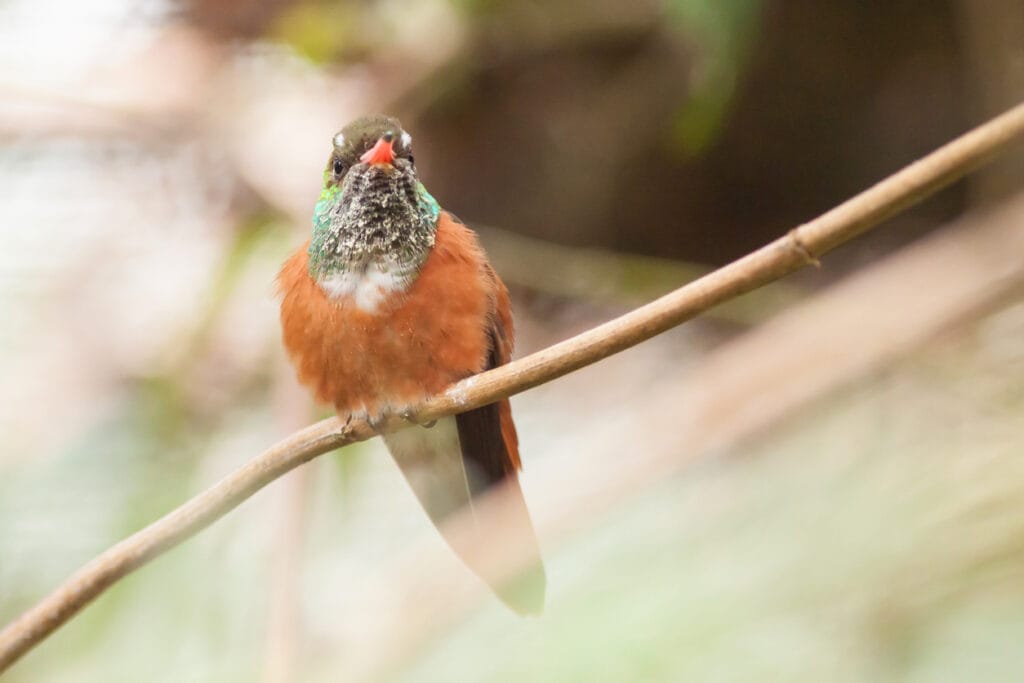
- Scientific name: Amazilia yucatanensis
- Length: 3.9 to 4.3 inches (10 to 11 cm)
- Weight: 0.07 to 0.14 ounces (2 to 4 g)
- Wingspan: 5.75 inches (14.6 cm)
Last but not least, the Buff-bellied Hummingbirds are among the largest species of hummingbirds you can find in the United States. It has a relatively long bill, wings, and tail.
Central America and Mexico are the main areas where this bird lives. It migrates during the winter to the southern coasts of the country, particularly in Louisiana and Texas.
That said, there’s been a few sightings of the Buff-bellied Hummingbird in Florida and Georgia from late fall to early spring.
These hummingbirds have a greenish copper plumage and their bills are red with a black tip. Their throats are an iridescent green-blue color and their bellies are a buff grey.
Wrap Up
There you have it, 13 hummingbirds in Georgia that you can spot during your next visit. If you live in the Peach State and looking to up your chances of encountering these tiny beauties, setting up nectar feeders is always a good idea.
We hope you enjoyed our guide on the most common hummingbirds in Georgia!
FAQ
As there are so many species visiting Georgia, try hanging a hummingbird feeder in you garden and see what comes. Alternatively, visit your local parks and gardens that have flowering plants.
The most common hummingbirds in Georgia are the Ruby-throated and Rufous Hummingbirds.
To find out where recent sightings of hummingbirds have been, try eBird. You can search for the latest sightings or particular species or what has been seen in a certain area.




